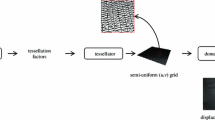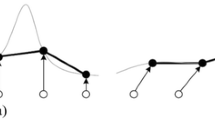Abstract
Terrain rendering has long been an interesting research topic, and Delaunay triangulation has been one of the methods frequently employed. The problem of smooth morphing between successive Delaunay meshes in a dynamic setting does not have a satisfactory solution however. In this paper, we address this issue by temporarily relieving the mesh from the strict constraints of Delaunay triangulation (DT). The proposed algorithm uses an off-line process to compute a relative importance for each sampling point in a Digital Elevation Model (DEM). It then constructs a mesh model in real-time from a set of points selected according to their viewpoint distances and relative importances. The mesh model is initialized to be a genuine DT. As the viewpoint moves, some points are added, and some are removed. We use simple methods for point insertion and removal that allow smooth morphing between successive frames. While the simple methods do not ensure Delaunay properties, we eliminate the slivery triangles gradually by collecting and flipping illegal edges incident to them. Point insertions, removals, edge flips, and their animations are organized by queueing and carried out over time. In this way, we amortize the burst computations to successive frames, so that a balanced workload and a high frame rate are achieved. The proposed algorithm produces a concise and well-composed mesh adaptive to both viewpoint and the terrain’s local geometry, and, most importantly, it supports smooth morphing.
Similar content being viewed by others
References
Apu, R., Gavrilova, M.: Gtvis: fast and efficient rendering system for real-time terrain visualization. In: Computational Science and Its Applications, pp. 592–602 (2004)
Bhattacharjee, S., Patidar, S., Narayanan, P.J.: Real-time rendering and manipulation of large terrains. In: Sixth Indian Conference on Computer Vision, Graphics & Image Processing, pp. 551–559 (2008)
CGAL: Computational geometry algorithms library. http://www.cgal.org (2010)
Cignoni, P., Ganovelli, F., Gobbetti, E., Marton, F., Ponchio, F., Scopigno, R.: BDAM-batched dynamic adaptive meshes for high performance terrain visualization. Comput. Graph. Forum 22(3), 505–514 (2003)
Cignoni, P., Ganovelli, F., Gobbetti, E., Marton, F., Ponchio, F., Scopigno, R.: Planet-sized batched dynamic adaptive meshes (P-BDAM). In: Proceedings of the 14th IEEE Visualization 2003 (VIS’03), p. 20 (2003)
Cohen-Or, D., Levanoni, Y.: Temporal continuity of levels of detail in Delaunay triangulated terrain. In: IEEE Visualization, pp. 37–42. IEEE Computer Society Press, Los Alamitos (1996)
De Berg, M., Dobrindt, K.: On levels of detail in terrains. Graph. Models Image Process. 60(1), 1–12 (1998)
De Berg, M., Cheong, O., Van Kreveld, M., Overmars, M.: Computational Geometry: Algorithms and Applications. Springer, New York (2008)
De Castro, M., Tournois, J., Alliez, P., Devillers, O.: Filtering relocations on a Delaunay triangulation. Comput. Graph. Forum 28(5) (2009)
Deb, S., Narayanan, P., Bhattacharjee, S.: Streaming terrain rendering. In: ACM SIGGRAPH 2006 Sketches, p. 181. ACM Press, New York (2006)
Debard, J., Balp, R., Chaine, R.: Dynamic Delaunay tetrahedralisation of a deforming surface. Vis. Comput. 23(12), 975–986 (2007)
Devillers, O., De Castro, M., et al.: State of the art: updating Delaunay triangulations for moving points. Tech. Rep. 00325816, INRIA (2008)
Duchaineau, M., Wolinsky, M., Sigeti, D., Miller, M., Aldrich, C., Mineev-Weinstein, M.: Roaming terrain: real-time optimally adapting meshes. In: IEEE Visualization, pp. 81–88. IEEE Computer Society Press, Los Alamitos (1997)
Dyer, R., Zhang, H., Möller, T.: Delaunay mesh construction. In: Proceedings of the Fifth Eurographics Symposium on Geometry Processing, p. 282. Eurographics Association, Geneva (2007)
Fowler, R., Little, J.: Automatic extraction of irregular network digital terrain models. In: SIGGRAPH, p. 207. ACM Press, New York (1979)
Garland, M., Heckbert, P.: Fast polygonal approximation of terrains and height fields. Tech. Rep. CMU-CS-95-181, Carnegie Mellon University (1995)
Gobbetti, E., Marton, F., Cignoni, P., Di Benedetto, M., Ganovelli, F.: C-BDAM-compressed batched dynamic adaptive meshes for terrain rendering. Comput. Graph. Forum 25(3), 333–342 (2006)
Hoppe, H.: Smooth view-dependent level-of-detail control and its application to terrain rendering. In: IEEE Visualization, pp. 35–42. IEEE Computer Society Press, Los Alamitos (1998)
Losasso, F., Hoppe, H.: Geometry clipmaps: terrain rendering using nested regular grids. In: IEEE Visualization, pp. 769–776. ACM Press, New York (2004)
Rabinovich, B., Gotsman, C.: Visualization of large terrains in resource-limited computing environments. In: IEEE Visualization, pp. 95–102. IEEE Computer Society Press, Los Alamitos (1997)
Rippa, S.: Minimal roughness property of the Delaunay triangulation. Comput. Aided Geom. Design 7, 489–497 (1990)
Valette, S., Chaine, R., Prost, R.: Progressive lossless mesh compression via incremental parametric refinement. Comput. Graph. Forum 28(5), 1301–1310 (2009)
Yang, S., Choi, Y., Lee, H.: CAD data visualization on mobile devices using sequential constrained Delaunay triangulation. Comput. Aided Design 41(5), 375–384 (2009)
Zhang, W.: Ringlike level of detail in real-time terrain rendering. In: International Conference on Environmental Science and Information Application Technology, pp. 716–719 (2009)
Zhang, H., Sun, J., Liu, J., Nan, L.: A new simplification method for terrain model using discrete particle swarm optimization. In: The 15th International Symposium on Advances in Geographic Information Systems (ACM GIS), pp. 1–4 (2007)
Author information
Authors and Affiliations
Corresponding author
Rights and permissions
About this article
Cite this article
Liu, X., Rokne, J.G. & Gavrilova, M.L. A novel terrain rendering algorithm based on quasi Delaunay triangulation. Vis Comput 26, 697–706 (2010). https://doi.org/10.1007/s00371-010-0440-3
Published:
Issue Date:
DOI: https://doi.org/10.1007/s00371-010-0440-3




